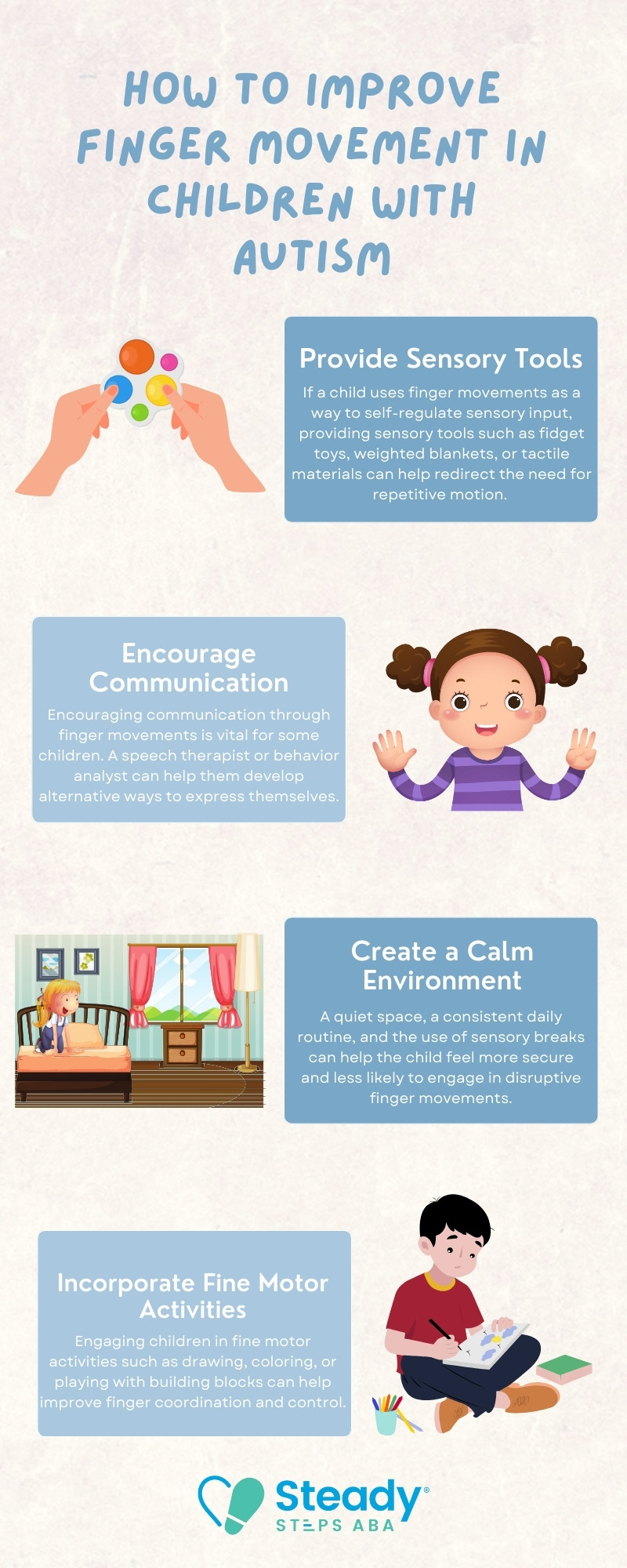Key Points:
- Finger movement in autism can be a form of self-regulation or communication.
- Understanding the different types of finger movements can help caregivers and therapists support children with autism.
- Finger movements may indicate sensory needs, emotional states, or attempts to focus.
Children with autism may exhibit a variety of behaviors that might be puzzling to those unfamiliar with the condition. One common and often noticeable behavior is finger movements, which can vary from simple hand-flapping to more complex repetitive motions.
These movements may appear distracting or out of place, but they often have a purpose, either serving as a self-soothing mechanism or a form of communication for a child who struggles to express themselves verbally.
Finger movements are part of the broader spectrum of motor behaviors observed in individuals with autism, such as stimming (self-stimulatory behaviors), and may have sensory, emotional, or cognitive significance. While these movements are an important part of understanding autism, it’s also crucial for parents, caregivers, and educators to learn how to support these behaviors in a way that promotes a child’s emotional and physical well-being.
In this article, we will explore the various types of finger movement in autism, why they occur, and how understanding these movements can lead to better strategies for managing them.
Why Do Finger Movements Occur in Children with Autism
Finger movements in children with autism often have a specific purpose. These movements can be a form of self-regulation, emotional expression, or sensory processing. Understanding why a child engages in finger movements is crucial for providing appropriate support and interventions. Here are some factors that often lead to finger movements in autistic children:
1. Self-Regulation
Many children with autism use finger movements as a form of self-regulation. These behaviors help to manage feelings of overwhelm, anxiety, or excitement. For instance, a child may engage in repetitive finger movements when they are stressed or overstimulated, as these movements provide a sense of comfort or grounding.
Self-regulation through these actions can be likened to other calming behaviors like rocking, hand-wringing, or even humming.
2. Sensory Processing Needs
Children with autism often have sensory processing challenges, meaning they may either be under-responsive or over-responsive to sensory stimuli. Finger movements, especially repetitive ones, can serve as a way for the child to provide proprioceptive feedback to their sensory system. If you’re curious about how specific tools like kinetic sand can support sensory regulation, our article “Is Kinetic Sand Good for Autism? Here’s What to Know“ explores its benefits and practical uses in more depth.
For example, small hand or finger motions can help the child process the sensation of touch, providing a calming effect that helps them cope with sensory overload.
3. Communication
In some cases, finger movements in autism are used as a form of nonverbal communication. A child may not have the ability or words to express themselves verbally, so they might use finger movements as a way to indicate their needs or emotions. For example, finger movements can signal frustration, excitement, or a desire for attention, and recognizing these behaviors can give caregivers a better understanding of what the child is trying to communicate.
3 Types of Finger Movements in Autism
Finger movements in children with autism can vary greatly from one individual to another. Understanding the different types of finger movements can help parents and caregivers identify the underlying cause and provide appropriate support:
1. Hand-Flapping
Hand-flapping is one of the most commonly observed behaviors in children with autism. It typically occurs when a child is excited, anxious, or overstimulated. This repetitive motion of waving or flapping the hands can serve as an outlet for intense emotions or sensory overload.
In some cases, hand-flapping is also seen as a form of self-stimulation or sensory seeking. While this behavior may be disruptive in certain settings, it’s important to understand that it serves a calming or regulating function for the child.
2. Fingers Twisting or Wiggling
Some children with autism engage in more specific finger movements, such as twisting or wiggling their fingers. These movements can be subtle, making them harder to notice, but they often provide similar sensory feedback to hand-flapping.
Like other forms of self-regulation, these small motions can help the child cope with anxiety, excitement, or sensory overload. They may also serve as a way for the child to focus attention or calm their body in response to a stressful situation.
3. Finger Flicking
Another common finger movement in autism is finger flicking, where a child may flick their fingers repeatedly in the air or against an object. This behavior can be a way for the child to seek sensory stimulation, or it could be a way to relieve tension or frustration. As with other repetitive motions, the flicking can be a coping mechanism that helps regulate emotional or sensory needs.
When Finger Movements in Autism May Indicate a Problem
While finger movements are a typical behavior for many children with autism, it is important for parents to be aware of when these movements may indicate a deeper issue or require intervention. Recognizing when finger movements interfere with the child’s daily functioning or development is key to knowing when to seek professional help. Below are some common scenarios:
1. Disruptive Behavior
If a child’s finger movements become excessively frequent or disruptive in public or social settings, it may be worth addressing. For example, if hand-flapping or finger-flicking consistently interferes with the child’s ability to engage in social interactions, play, or focus, it could indicate that the child needs additional support or interventions.
2. Physical Harm
In rare cases, repetitive finger movements or hand-flapping can result in physical harm, such as skin irritation or injury from excessive motion. If the movements cause the child physical discomfort, or if they begin to harm themselves or others, it’s essential to consult with a healthcare professional for guidance on how to manage the behavior safely.
3. Difficulty with Communication
If the child’s finger movements are the only form of communication they use, and they struggle with verbal or alternative communication methods, it may indicate a more significant communication delay. In such cases, it’s important to work with a speech therapist or behavior analyst to help the child develop appropriate communication skills.
How to Improve Finger Movement in Children with Autism
Supporting children who engage in finger movements involves understanding the purpose behind the behavior and providing appropriate outlets or interventions. Here are a few strategies that can help:

Get the Support You Need with ABA Therapy
Understanding finger movement in autism can provide valuable insights into how children with autism regulate their emotions, communicate, and process sensory information. By recognizing the underlying causes of these movements, caregivers and therapists can offer appropriate interventions that support the child’s development and well-being.
At Steady Steps ABA, we specialize in providing personalized ABA therapy in Maryland to help children with autism manage behaviors like finger movements. Our approach focuses on teaching essential life skills, enhancing communication, and teaching helpful techniques like shaping.
If you’re looking for support with your child’s behaviors, including those related to finger movements, we’re here to help. Get in touch with us today to learn more about how our ABA therapy services can support your child’s growth!




